Examining Digital Workplace Transformation in Vietnamese Telecoms
VerifiedAdded on 2022/03/28
|15
|4008
|10
Project
AI Summary
This project investigates the key factors influencing digital workplace transformation within the Vietnamese telecommunications industry. The research, based on a quantitative survey of 34 workers and managers from Viettel, VNPT, and FPT, identifies leadership and employee performance & competence as primary drivers of successful digital transformation. The study provides an overview of the current state of digital transformation, identifies the major factors influencing the digital transformation of these companies' workplaces, and examines how these factors influence firms during the workplace's digital transition. The methodology includes questionnaire construction, data collection through a non-probability snowball sampling method, and data analysis using descriptive statistics. The findings highlight the significance of leadership alignment and employee capabilities in achieving digital transformation goals, providing valuable insights for telecommunications companies and other industries undergoing similar transitions. Comparisons with past studies are offered to analyze the transformation in telecommunications firms as well as enterprises in other industries.
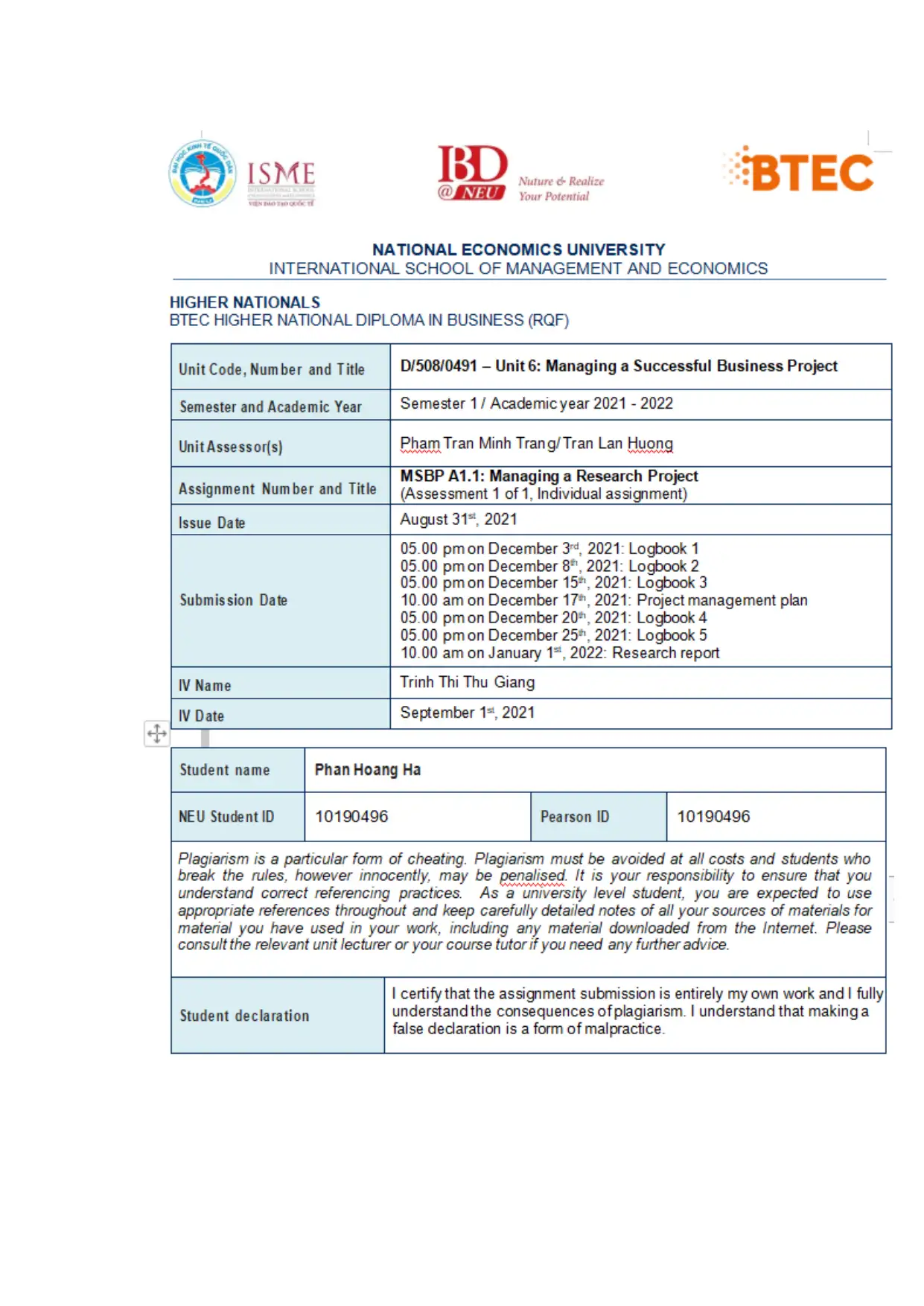
Paraphrase This Document
Need a fresh take? Get an instant paraphrase of this document with our AI Paraphraser

Table of Content
I. Abstract:......................................................................................................................3
II. Introduction:..............................................................................................................3
III. Literature Review.....................................................................................................4
IV. Methodology............................................................................................................7
V. Findings and discussion.............................................................................................9
VI. Conclusion and recommendations.........................................................................13
VII. Project reflection...................................................................................................13
VIII. Reference............................................................................................................'14
IX. Appendix................................................................................................................16
To examine the key factors influencing digital workplace transformation in
Vietnamese telecommunications organizations
Word count: 2938 words
I. Abstract:......................................................................................................................3
II. Introduction:..............................................................................................................3
III. Literature Review.....................................................................................................4
IV. Methodology............................................................................................................7
V. Findings and discussion.............................................................................................9
VI. Conclusion and recommendations.........................................................................13
VII. Project reflection...................................................................................................13
VIII. Reference............................................................................................................'14
IX. Appendix................................................................................................................16
To examine the key factors influencing digital workplace transformation in
Vietnamese telecommunications organizations
Word count: 2938 words
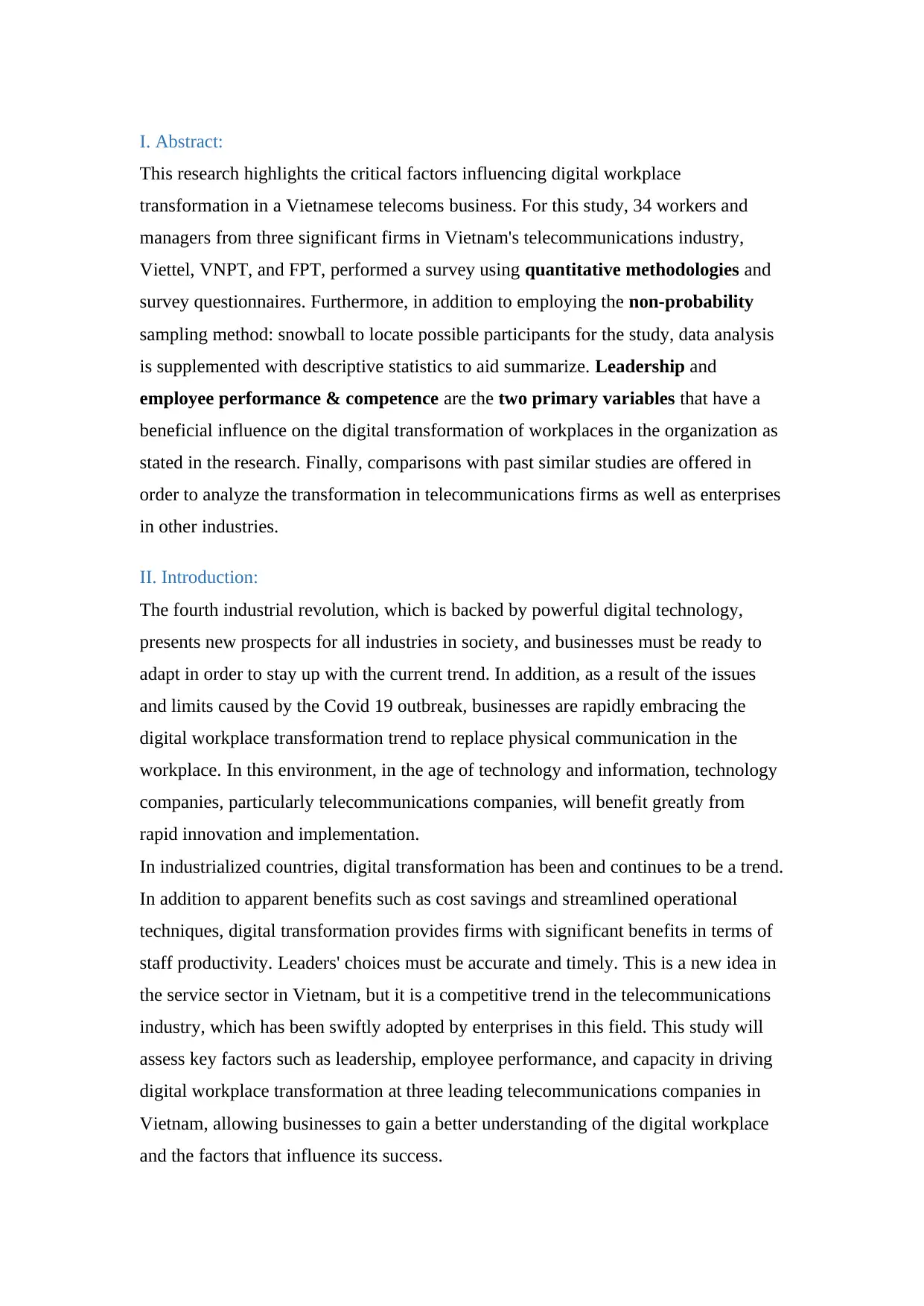
I. Abstract:
This research highlights the critical factors influencing digital workplace
transformation in a Vietnamese telecoms business. For this study, 34 workers and
managers from three significant firms in Vietnam's telecommunications industry,
Viettel, VNPT, and FPT, performed a survey using quantitative methodologies and
survey questionnaires. Furthermore, in addition to employing the non-probability
sampling method: snowball to locate possible participants for the study, data analysis
is supplemented with descriptive statistics to aid summarize. Leadership and
employee performance & competence are the two primary variables that have a
beneficial influence on the digital transformation of workplaces in the organization as
stated in the research. Finally, comparisons with past similar studies are offered in
order to analyze the transformation in telecommunications firms as well as enterprises
in other industries.
II. Introduction:
The fourth industrial revolution, which is backed by powerful digital technology,
presents new prospects for all industries in society, and businesses must be ready to
adapt in order to stay up with the current trend. In addition, as a result of the issues
and limits caused by the Covid 19 outbreak, businesses are rapidly embracing the
digital workplace transformation trend to replace physical communication in the
workplace. In this environment, in the age of technology and information, technology
companies, particularly telecommunications companies, will benefit greatly from
rapid innovation and implementation.
In industrialized countries, digital transformation has been and continues to be a trend.
In addition to apparent benefits such as cost savings and streamlined operational
techniques, digital transformation provides firms with significant benefits in terms of
staff productivity. Leaders' choices must be accurate and timely. This is a new idea in
the service sector in Vietnam, but it is a competitive trend in the telecommunications
industry, which has been swiftly adopted by enterprises in this field. This study will
assess key factors such as leadership, employee performance, and capacity in driving
digital workplace transformation at three leading telecommunications companies in
Vietnam, allowing businesses to gain a better understanding of the digital workplace
and the factors that influence its success.
This research highlights the critical factors influencing digital workplace
transformation in a Vietnamese telecoms business. For this study, 34 workers and
managers from three significant firms in Vietnam's telecommunications industry,
Viettel, VNPT, and FPT, performed a survey using quantitative methodologies and
survey questionnaires. Furthermore, in addition to employing the non-probability
sampling method: snowball to locate possible participants for the study, data analysis
is supplemented with descriptive statistics to aid summarize. Leadership and
employee performance & competence are the two primary variables that have a
beneficial influence on the digital transformation of workplaces in the organization as
stated in the research. Finally, comparisons with past similar studies are offered in
order to analyze the transformation in telecommunications firms as well as enterprises
in other industries.
II. Introduction:
The fourth industrial revolution, which is backed by powerful digital technology,
presents new prospects for all industries in society, and businesses must be ready to
adapt in order to stay up with the current trend. In addition, as a result of the issues
and limits caused by the Covid 19 outbreak, businesses are rapidly embracing the
digital workplace transformation trend to replace physical communication in the
workplace. In this environment, in the age of technology and information, technology
companies, particularly telecommunications companies, will benefit greatly from
rapid innovation and implementation.
In industrialized countries, digital transformation has been and continues to be a trend.
In addition to apparent benefits such as cost savings and streamlined operational
techniques, digital transformation provides firms with significant benefits in terms of
staff productivity. Leaders' choices must be accurate and timely. This is a new idea in
the service sector in Vietnam, but it is a competitive trend in the telecommunications
industry, which has been swiftly adopted by enterprises in this field. This study will
assess key factors such as leadership, employee performance, and capacity in driving
digital workplace transformation at three leading telecommunications companies in
Vietnam, allowing businesses to gain a better understanding of the digital workplace
and the factors that influence its success.
⊘ This is a preview!⊘
Do you want full access?
Subscribe today to unlock all pages.

Trusted by 1+ million students worldwide

The study aim is to investigate the elements that influence digital workplace digital
transformation in Vietnamese telecommunications companies.
The study's goals are divided into three categories. To begin, give an overview of
the present state of digital transformation in Vietnam's telecoms companies. Next,
identify the major factors that influence the digital transformation of these companies'
workplaces, including leadership, employee performance, and capabilities. Finally,
consider how these factors influence firms during the workplace's digital transition.
Three questions must be answered explicitly throughout the research. Through three
companies, Viettel, VNPT, and FPT, about the present state of digital transformation
in the telecommunications business. Second, what are the most important variables
influencing the digital transformation of workplaces in telecoms companies? Third,
assess the criteria of these aspects that have a negative or positive impact on
workplace digital transformation.
III. Literature Review
This section will provide an overview of the DWT scenario in the telecoms sector as a
whole. In addition, discuss significant hypotheses concerning the elements that
influence this process and how those aspects are taken into account. Contributions and
theories for the theory's development will be explored in the end.
1. General Review:
The phrase "digital workplace" refers to the concept of physical workplaces becoming
obsolete in an era of technical advancement in electronic equipment and technology,
as well as telecommunications services. It is often regarded as the predecessor of
internal 2.0 solutions, and it is based on three primary pillars: communication,
collaboration, and information. (Attaran, Attaran and Kirkland, 2019)This is a
significant shift in the company organization paradigm as a result of data
digitalization, which has an impact on all elements of corporate culture and
leadership. (Sow and Aborbie, 2018) Furthermore, each company's move from
traditional to digital workplaces is influenced by its own approaches and frameworks.
In many firms, the principles that digital transformation delivers have radically
transformed how organizations work, business models, and created a strong creative
culture (Nambisan, Wright and Feldman, 2019). The telecom business in Vietnam is
transformation in Vietnamese telecommunications companies.
The study's goals are divided into three categories. To begin, give an overview of
the present state of digital transformation in Vietnam's telecoms companies. Next,
identify the major factors that influence the digital transformation of these companies'
workplaces, including leadership, employee performance, and capabilities. Finally,
consider how these factors influence firms during the workplace's digital transition.
Three questions must be answered explicitly throughout the research. Through three
companies, Viettel, VNPT, and FPT, about the present state of digital transformation
in the telecommunications business. Second, what are the most important variables
influencing the digital transformation of workplaces in telecoms companies? Third,
assess the criteria of these aspects that have a negative or positive impact on
workplace digital transformation.
III. Literature Review
This section will provide an overview of the DWT scenario in the telecoms sector as a
whole. In addition, discuss significant hypotheses concerning the elements that
influence this process and how those aspects are taken into account. Contributions and
theories for the theory's development will be explored in the end.
1. General Review:
The phrase "digital workplace" refers to the concept of physical workplaces becoming
obsolete in an era of technical advancement in electronic equipment and technology,
as well as telecommunications services. It is often regarded as the predecessor of
internal 2.0 solutions, and it is based on three primary pillars: communication,
collaboration, and information. (Attaran, Attaran and Kirkland, 2019)This is a
significant shift in the company organization paradigm as a result of data
digitalization, which has an impact on all elements of corporate culture and
leadership. (Sow and Aborbie, 2018) Furthermore, each company's move from
traditional to digital workplaces is influenced by its own approaches and frameworks.
In many firms, the principles that digital transformation delivers have radically
transformed how organizations work, business models, and created a strong creative
culture (Nambisan, Wright and Feldman, 2019). The telecom business in Vietnam is
Paraphrase This Document
Need a fresh take? Get an instant paraphrase of this document with our AI Paraphraser
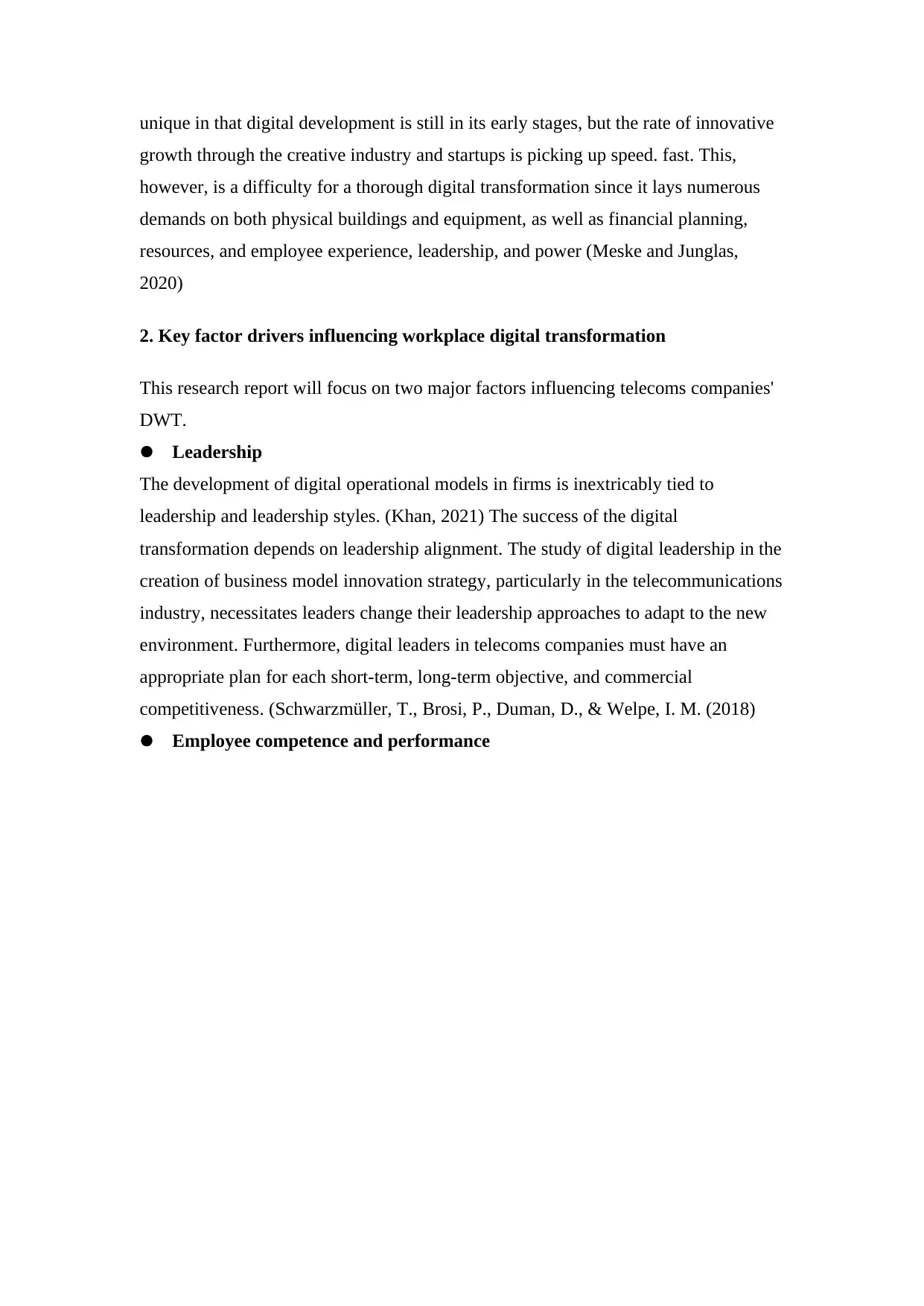
unique in that digital development is still in its early stages, but the rate of innovative
growth through the creative industry and startups is picking up speed. fast. This,
however, is a difficulty for a thorough digital transformation since it lays numerous
demands on both physical buildings and equipment, as well as financial planning,
resources, and employee experience, leadership, and power (Meske and Junglas,
2020)
2. Key factor drivers influencing workplace digital transformation
This research report will focus on two major factors influencing telecoms companies'
DWT.
Leadership
The development of digital operational models in firms is inextricably tied to
leadership and leadership styles. (Khan, 2021) The success of the digital
transformation depends on leadership alignment. The study of digital leadership in the
creation of business model innovation strategy, particularly in the telecommunications
industry, necessitates leaders change their leadership approaches to adapt to the new
environment. Furthermore, digital leaders in telecoms companies must have an
appropriate plan for each short-term, long-term objective, and commercial
competitiveness. (Schwarzmüller, T., Brosi, P., Duman, D., & Welpe, I. M. (2018)
Employee competence and performance
growth through the creative industry and startups is picking up speed. fast. This,
however, is a difficulty for a thorough digital transformation since it lays numerous
demands on both physical buildings and equipment, as well as financial planning,
resources, and employee experience, leadership, and power (Meske and Junglas,
2020)
2. Key factor drivers influencing workplace digital transformation
This research report will focus on two major factors influencing telecoms companies'
DWT.
Leadership
The development of digital operational models in firms is inextricably tied to
leadership and leadership styles. (Khan, 2021) The success of the digital
transformation depends on leadership alignment. The study of digital leadership in the
creation of business model innovation strategy, particularly in the telecommunications
industry, necessitates leaders change their leadership approaches to adapt to the new
environment. Furthermore, digital leaders in telecoms companies must have an
appropriate plan for each short-term, long-term objective, and commercial
competitiveness. (Schwarzmüller, T., Brosi, P., Duman, D., & Welpe, I. M. (2018)
Employee competence and performance
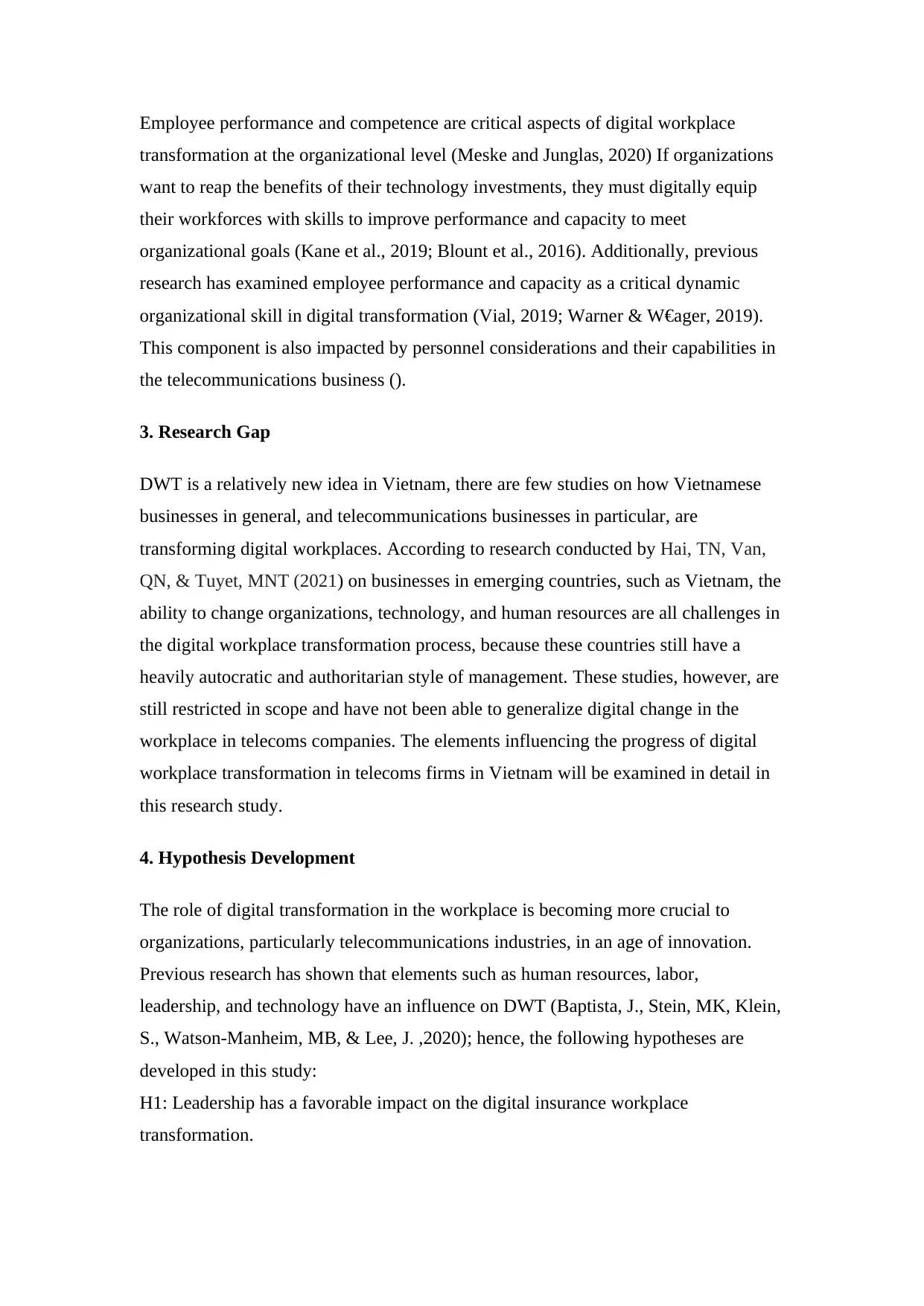
Employee performance and competence are critical aspects of digital workplace
transformation at the organizational level (Meske and Junglas, 2020) If organizations
want to reap the benefits of their technology investments, they must digitally equip
their workforces with skills to improve performance and capacity to meet
organizational goals (Kane et al., 2019; Blount et al., 2016). Additionally, previous
research has examined employee performance and capacity as a critical dynamic
organizational skill in digital transformation (Vial, 2019; Warner & W€ager, 2019).
This component is also impacted by personnel considerations and their capabilities in
the telecommunications business ().
3. Research Gap
DWT is a relatively new idea in Vietnam, there are few studies on how Vietnamese
businesses in general, and telecommunications businesses in particular, are
transforming digital workplaces. According to research conducted by Hai, TN, Van,
QN, & Tuyet, MNT (2021) on businesses in emerging countries, such as Vietnam, the
ability to change organizations, technology, and human resources are all challenges in
the digital workplace transformation process, because these countries still have a
heavily autocratic and authoritarian style of management. These studies, however, are
still restricted in scope and have not been able to generalize digital change in the
workplace in telecoms companies. The elements influencing the progress of digital
workplace transformation in telecoms firms in Vietnam will be examined in detail in
this research study.
4. Hypothesis Development
The role of digital transformation in the workplace is becoming more crucial to
organizations, particularly telecommunications industries, in an age of innovation.
Previous research has shown that elements such as human resources, labor,
leadership, and technology have an influence on DWT (Baptista, J., Stein, MK, Klein,
S., Watson-Manheim, MB, & Lee, J. ,2020); hence, the following hypotheses are
developed in this study:
H1: Leadership has a favorable impact on the digital insurance workplace
transformation.
transformation at the organizational level (Meske and Junglas, 2020) If organizations
want to reap the benefits of their technology investments, they must digitally equip
their workforces with skills to improve performance and capacity to meet
organizational goals (Kane et al., 2019; Blount et al., 2016). Additionally, previous
research has examined employee performance and capacity as a critical dynamic
organizational skill in digital transformation (Vial, 2019; Warner & W€ager, 2019).
This component is also impacted by personnel considerations and their capabilities in
the telecommunications business ().
3. Research Gap
DWT is a relatively new idea in Vietnam, there are few studies on how Vietnamese
businesses in general, and telecommunications businesses in particular, are
transforming digital workplaces. According to research conducted by Hai, TN, Van,
QN, & Tuyet, MNT (2021) on businesses in emerging countries, such as Vietnam, the
ability to change organizations, technology, and human resources are all challenges in
the digital workplace transformation process, because these countries still have a
heavily autocratic and authoritarian style of management. These studies, however, are
still restricted in scope and have not been able to generalize digital change in the
workplace in telecoms companies. The elements influencing the progress of digital
workplace transformation in telecoms firms in Vietnam will be examined in detail in
this research study.
4. Hypothesis Development
The role of digital transformation in the workplace is becoming more crucial to
organizations, particularly telecommunications industries, in an age of innovation.
Previous research has shown that elements such as human resources, labor,
leadership, and technology have an influence on DWT (Baptista, J., Stein, MK, Klein,
S., Watson-Manheim, MB, & Lee, J. ,2020); hence, the following hypotheses are
developed in this study:
H1: Leadership has a favorable impact on the digital insurance workplace
transformation.
⊘ This is a preview!⊘
Do you want full access?
Subscribe today to unlock all pages.

Trusted by 1+ million students worldwide

H2: In the telecommunications industry, employee performance and competence have
a favorable impact on workplace change.
IV. Methodology
This study employs a quantitative approach. For starters, the quantitative technique
includes a bigger sample size and provides an overview of industry facts and
scenarios. Second, theories regarding elements influencing the process and research
frameworks are already established for the subject of workplace digital
transformation, thus the qualitative technique aids in testing the theories against large
data files.
1. Questionnaire construction
According to previous studies, the questionnaire (in the appendix) was developed
based on the theories in the literature review with sources from Claassen, K., dos
Anjos, D., Kettschau, J., and Broding, H., 2021 and Meske, Christian & Junglas, Iris.
(2020) for personal questions; Kane, G. C., Palmer, D., Phillips, A. N., Kiron, D., &
Buck (2001)
2. Data collection
Sample size: The survey was done with 35 respondents, including managers and staff,
from three main telecommunications companies in Vietnam, Viettel, VNPT, and FPT,
to provide an objective perspective and support for the hypothesis This sample size is
the smallest that is suitable for the study's purpose and goals. Because this is research
on digital transformation in telecoms organizations, obtaining input from both
workers and corporate management will assist the study get a better understanding of
their impact on the digital transformation process. In the business, there is an office.
Furthermore, the internal elements of the firm will be the factors that comprehend
both the operation method and the company's surroundings, making this an
appropriate study object.
Sampling method: The survey used a non-probability sampling approach combined
with a snowball sampling strategy to reach out to participants. The author has contact
with Viettel's human resources director, which allows him to transmit questions to the
company's workers; also, at VNPT and FPT, the author was assisted by staff and
a favorable impact on workplace change.
IV. Methodology
This study employs a quantitative approach. For starters, the quantitative technique
includes a bigger sample size and provides an overview of industry facts and
scenarios. Second, theories regarding elements influencing the process and research
frameworks are already established for the subject of workplace digital
transformation, thus the qualitative technique aids in testing the theories against large
data files.
1. Questionnaire construction
According to previous studies, the questionnaire (in the appendix) was developed
based on the theories in the literature review with sources from Claassen, K., dos
Anjos, D., Kettschau, J., and Broding, H., 2021 and Meske, Christian & Junglas, Iris.
(2020) for personal questions; Kane, G. C., Palmer, D., Phillips, A. N., Kiron, D., &
Buck (2001)
2. Data collection
Sample size: The survey was done with 35 respondents, including managers and staff,
from three main telecommunications companies in Vietnam, Viettel, VNPT, and FPT,
to provide an objective perspective and support for the hypothesis This sample size is
the smallest that is suitable for the study's purpose and goals. Because this is research
on digital transformation in telecoms organizations, obtaining input from both
workers and corporate management will assist the study get a better understanding of
their impact on the digital transformation process. In the business, there is an office.
Furthermore, the internal elements of the firm will be the factors that comprehend
both the operation method and the company's surroundings, making this an
appropriate study object.
Sampling method: The survey used a non-probability sampling approach combined
with a snowball sampling strategy to reach out to participants. The author has contact
with Viettel's human resources director, which allows him to transmit questions to the
company's workers; also, at VNPT and FPT, the author was assisted by staff and
Paraphrase This Document
Need a fresh take? Get an instant paraphrase of this document with our AI Paraphraser

managers in the HR department to complete the survey. Although the sample's
representativeness and control alkalinity cannot be guaranteed since the subjects that
the researcher can collect are mostly based on previously observed subjects, the
sample's representativeness and control alkalinity may be. Because these are the three
largest telecommunications companies in Vietnam, the representation of the telecoms
sector will be improved to some extent.
3. Data analysis
Description: A questionnaire was created using Google Forms and then given to
Viettel workers through an emailed link, with the request that they forward it to three
colleagues from the same business to assist carry out the sample survey. The survey
was delivered by Viettel's human resources director after a full survey was ready.
Questionnaires were sent down from the HR department via email to at least 10
workers at each of the remaining two businesses. The data and statistics were
collected from 35 workers at three firms over the course of two days.
The questionnaire was then translated to Excel format and cleaned to 34 responses
(removing any questions that were incomplete, misleading, or contradictory), coding,
and utilizing functions (Min, Max, Mean, Std, Correl) to determine the correlation
coefficient of each hypothesis.
4. Attachments
Online survey link: https://forms.gle/PN5Ftt4Us5HpSsM27
Excel page for raw data:
https://docs.google.com/spreadsheets/d/19A8ydruBFNGJQQuBrpyR7S0_TEd_8W51
8alfGbhskN4/edit?usp=sharing
V. Findings and discussion
The study sample includes 35 workers from three Vietnamese telecommunications
companies: Viettel, FPT, and VNPT. Sex, age, and job experience at the company all
contribute to the data's generality and variety. Because this is the major group of
workers at the company, notably in the digitalization divisions, the questionnaire
sample has a considerable difference in the young age group (22-35 years old) with
44,1% while just 26,5% of persons aged 35-50 . To acquire the most comprehensive
representativeness and control alkalinity cannot be guaranteed since the subjects that
the researcher can collect are mostly based on previously observed subjects, the
sample's representativeness and control alkalinity may be. Because these are the three
largest telecommunications companies in Vietnam, the representation of the telecoms
sector will be improved to some extent.
3. Data analysis
Description: A questionnaire was created using Google Forms and then given to
Viettel workers through an emailed link, with the request that they forward it to three
colleagues from the same business to assist carry out the sample survey. The survey
was delivered by Viettel's human resources director after a full survey was ready.
Questionnaires were sent down from the HR department via email to at least 10
workers at each of the remaining two businesses. The data and statistics were
collected from 35 workers at three firms over the course of two days.
The questionnaire was then translated to Excel format and cleaned to 34 responses
(removing any questions that were incomplete, misleading, or contradictory), coding,
and utilizing functions (Min, Max, Mean, Std, Correl) to determine the correlation
coefficient of each hypothesis.
4. Attachments
Online survey link: https://forms.gle/PN5Ftt4Us5HpSsM27
Excel page for raw data:
https://docs.google.com/spreadsheets/d/19A8ydruBFNGJQQuBrpyR7S0_TEd_8W51
8alfGbhskN4/edit?usp=sharing
V. Findings and discussion
The study sample includes 35 workers from three Vietnamese telecommunications
companies: Viettel, FPT, and VNPT. Sex, age, and job experience at the company all
contribute to the data's generality and variety. Because this is the major group of
workers at the company, notably in the digitalization divisions, the questionnaire
sample has a considerable difference in the young age group (22-35 years old) with
44,1% while just 26,5% of persons aged 35-50 . To acquire the most comprehensive

perspective of the industry, the number of interviewers in each of the three firms is
equal. Finally, in terms of research experience, the majority of the survey participants
are of advanced age, allowing them to comprehend both internal and external working
procedures at the organization, with 58,8%.
equal. Finally, in terms of research experience, the majority of the survey participants
are of advanced age, allowing them to comprehend both internal and external working
procedures at the organization, with 58,8%.
⊘ This is a preview!⊘
Do you want full access?
Subscribe today to unlock all pages.

Trusted by 1+ million students worldwide

1. An overview of the present state of digital transformation in Vietnam's
telecoms companies
The digital transformation scenario is shown in a column chart based on the growth of
digital tools and workplace digital cooperation, such as the electronic storage of
telecoms companies
The digital transformation scenario is shown in a column chart based on the growth of
digital tools and workplace digital cooperation, such as the electronic storage of
Paraphrase This Document
Need a fresh take? Get an instant paraphrase of this document with our AI Paraphraser
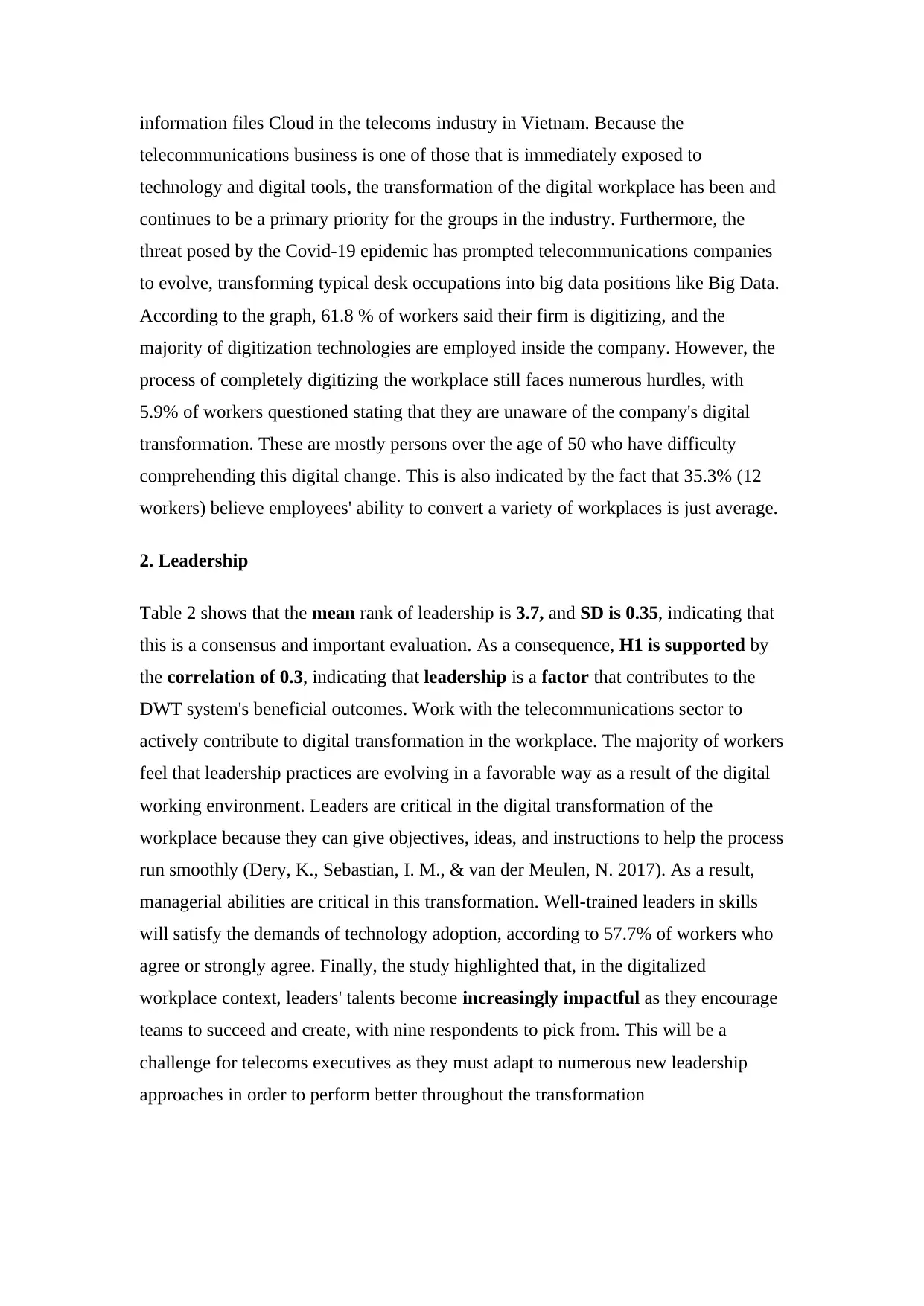
information files Cloud in the telecoms industry in Vietnam. Because the
telecommunications business is one of those that is immediately exposed to
technology and digital tools, the transformation of the digital workplace has been and
continues to be a primary priority for the groups in the industry. Furthermore, the
threat posed by the Covid-19 epidemic has prompted telecommunications companies
to evolve, transforming typical desk occupations into big data positions like Big Data.
According to the graph, 61.8 % of workers said their firm is digitizing, and the
majority of digitization technologies are employed inside the company. However, the
process of completely digitizing the workplace still faces numerous hurdles, with
5.9% of workers questioned stating that they are unaware of the company's digital
transformation. These are mostly persons over the age of 50 who have difficulty
comprehending this digital change. This is also indicated by the fact that 35.3% (12
workers) believe employees' ability to convert a variety of workplaces is just average.
2. Leadership
Table 2 shows that the mean rank of leadership is 3.7, and SD is 0.35, indicating that
this is a consensus and important evaluation. As a consequence, H1 is supported by
the correlation of 0.3, indicating that leadership is a factor that contributes to the
DWT system's beneficial outcomes. Work with the telecommunications sector to
actively contribute to digital transformation in the workplace. The majority of workers
feel that leadership practices are evolving in a favorable way as a result of the digital
working environment. Leaders are critical in the digital transformation of the
workplace because they can give objectives, ideas, and instructions to help the process
run smoothly (Dery, K., Sebastian, I. M., & van der Meulen, N. 2017). As a result,
managerial abilities are critical in this transformation. Well-trained leaders in skills
will satisfy the demands of technology adoption, according to 57.7% of workers who
agree or strongly agree. Finally, the study highlighted that, in the digitalized
workplace context, leaders' talents become increasingly impactful as they encourage
teams to succeed and create, with nine respondents to pick from. This will be a
challenge for telecoms executives as they must adapt to numerous new leadership
approaches in order to perform better throughout the transformation
telecommunications business is one of those that is immediately exposed to
technology and digital tools, the transformation of the digital workplace has been and
continues to be a primary priority for the groups in the industry. Furthermore, the
threat posed by the Covid-19 epidemic has prompted telecommunications companies
to evolve, transforming typical desk occupations into big data positions like Big Data.
According to the graph, 61.8 % of workers said their firm is digitizing, and the
majority of digitization technologies are employed inside the company. However, the
process of completely digitizing the workplace still faces numerous hurdles, with
5.9% of workers questioned stating that they are unaware of the company's digital
transformation. These are mostly persons over the age of 50 who have difficulty
comprehending this digital change. This is also indicated by the fact that 35.3% (12
workers) believe employees' ability to convert a variety of workplaces is just average.
2. Leadership
Table 2 shows that the mean rank of leadership is 3.7, and SD is 0.35, indicating that
this is a consensus and important evaluation. As a consequence, H1 is supported by
the correlation of 0.3, indicating that leadership is a factor that contributes to the
DWT system's beneficial outcomes. Work with the telecommunications sector to
actively contribute to digital transformation in the workplace. The majority of workers
feel that leadership practices are evolving in a favorable way as a result of the digital
working environment. Leaders are critical in the digital transformation of the
workplace because they can give objectives, ideas, and instructions to help the process
run smoothly (Dery, K., Sebastian, I. M., & van der Meulen, N. 2017). As a result,
managerial abilities are critical in this transformation. Well-trained leaders in skills
will satisfy the demands of technology adoption, according to 57.7% of workers who
agree or strongly agree. Finally, the study highlighted that, in the digitalized
workplace context, leaders' talents become increasingly impactful as they encourage
teams to succeed and create, with nine respondents to pick from. This will be a
challenge for telecoms executives as they must adapt to numerous new leadership
approaches in order to perform better throughout the transformation
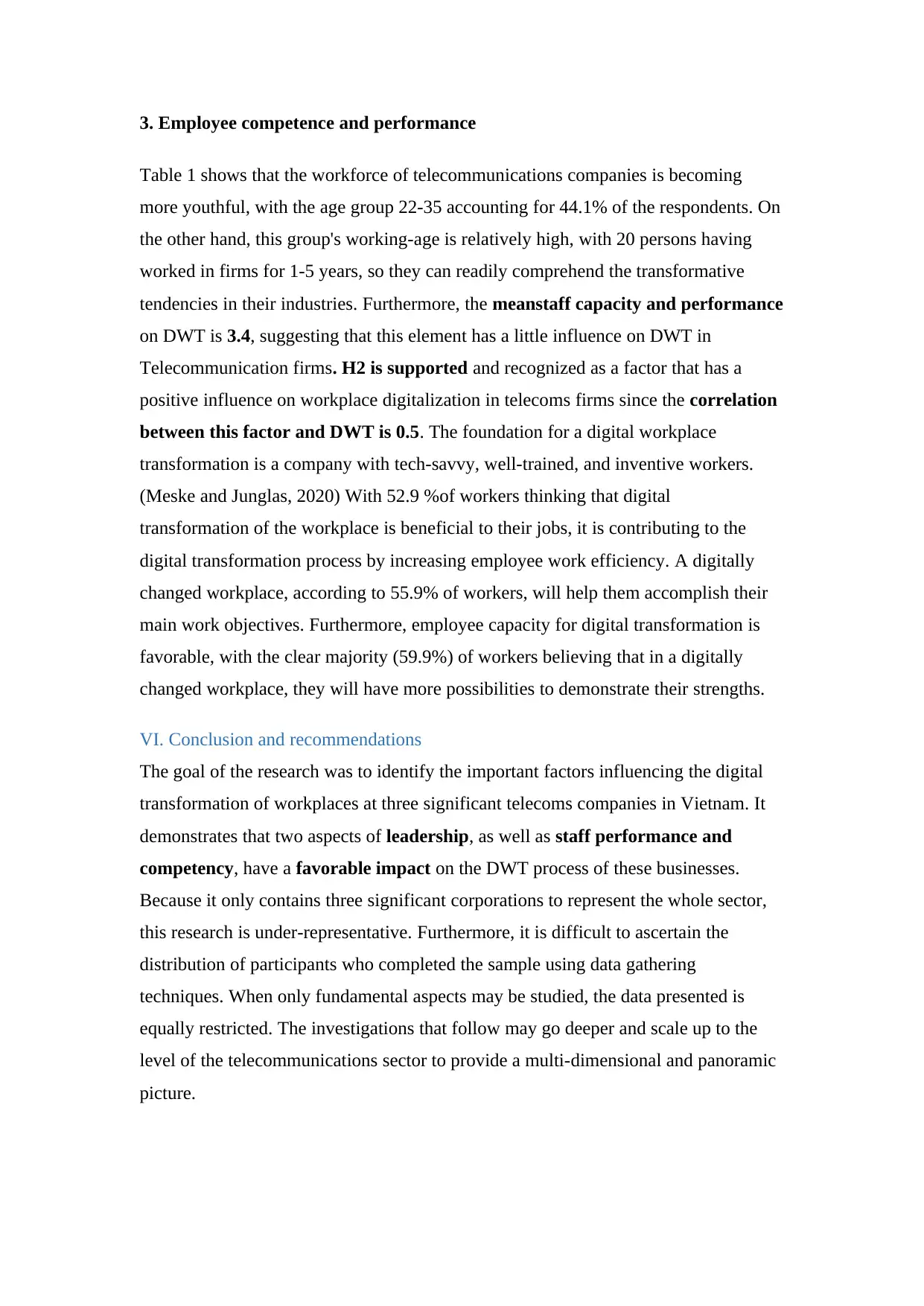
3. Employee competence and performance
Table 1 shows that the workforce of telecommunications companies is becoming
more youthful, with the age group 22-35 accounting for 44.1% of the respondents. On
the other hand, this group's working-age is relatively high, with 20 persons having
worked in firms for 1-5 years, so they can readily comprehend the transformative
tendencies in their industries. Furthermore, the meanstaff capacity and performance
on DWT is 3.4, suggesting that this element has a little influence on DWT in
Telecommunication firms. H2 is supported and recognized as a factor that has a
positive influence on workplace digitalization in telecoms firms since the correlation
between this factor and DWT is 0.5. The foundation for a digital workplace
transformation is a company with tech-savvy, well-trained, and inventive workers.
(Meske and Junglas, 2020) With 52.9 %of workers thinking that digital
transformation of the workplace is beneficial to their jobs, it is contributing to the
digital transformation process by increasing employee work efficiency. A digitally
changed workplace, according to 55.9% of workers, will help them accomplish their
main work objectives. Furthermore, employee capacity for digital transformation is
favorable, with the clear majority (59.9%) of workers believing that in a digitally
changed workplace, they will have more possibilities to demonstrate their strengths.
VI. Conclusion and recommendations
The goal of the research was to identify the important factors influencing the digital
transformation of workplaces at three significant telecoms companies in Vietnam. It
demonstrates that two aspects of leadership, as well as staff performance and
competency, have a favorable impact on the DWT process of these businesses.
Because it only contains three significant corporations to represent the whole sector,
this research is under-representative. Furthermore, it is difficult to ascertain the
distribution of participants who completed the sample using data gathering
techniques. When only fundamental aspects may be studied, the data presented is
equally restricted. The investigations that follow may go deeper and scale up to the
level of the telecommunications sector to provide a multi-dimensional and panoramic
picture.
Table 1 shows that the workforce of telecommunications companies is becoming
more youthful, with the age group 22-35 accounting for 44.1% of the respondents. On
the other hand, this group's working-age is relatively high, with 20 persons having
worked in firms for 1-5 years, so they can readily comprehend the transformative
tendencies in their industries. Furthermore, the meanstaff capacity and performance
on DWT is 3.4, suggesting that this element has a little influence on DWT in
Telecommunication firms. H2 is supported and recognized as a factor that has a
positive influence on workplace digitalization in telecoms firms since the correlation
between this factor and DWT is 0.5. The foundation for a digital workplace
transformation is a company with tech-savvy, well-trained, and inventive workers.
(Meske and Junglas, 2020) With 52.9 %of workers thinking that digital
transformation of the workplace is beneficial to their jobs, it is contributing to the
digital transformation process by increasing employee work efficiency. A digitally
changed workplace, according to 55.9% of workers, will help them accomplish their
main work objectives. Furthermore, employee capacity for digital transformation is
favorable, with the clear majority (59.9%) of workers believing that in a digitally
changed workplace, they will have more possibilities to demonstrate their strengths.
VI. Conclusion and recommendations
The goal of the research was to identify the important factors influencing the digital
transformation of workplaces at three significant telecoms companies in Vietnam. It
demonstrates that two aspects of leadership, as well as staff performance and
competency, have a favorable impact on the DWT process of these businesses.
Because it only contains three significant corporations to represent the whole sector,
this research is under-representative. Furthermore, it is difficult to ascertain the
distribution of participants who completed the sample using data gathering
techniques. When only fundamental aspects may be studied, the data presented is
equally restricted. The investigations that follow may go deeper and scale up to the
level of the telecommunications sector to provide a multi-dimensional and panoramic
picture.
⊘ This is a preview!⊘
Do you want full access?
Subscribe today to unlock all pages.

Trusted by 1+ million students worldwide
1 out of 15
Related Documents
Your All-in-One AI-Powered Toolkit for Academic Success.
+13062052269
info@desklib.com
Available 24*7 on WhatsApp / Email
![[object Object]](/_next/static/media/star-bottom.7253800d.svg)
Unlock your academic potential
Copyright © 2020–2025 A2Z Services. All Rights Reserved. Developed and managed by ZUCOL.





